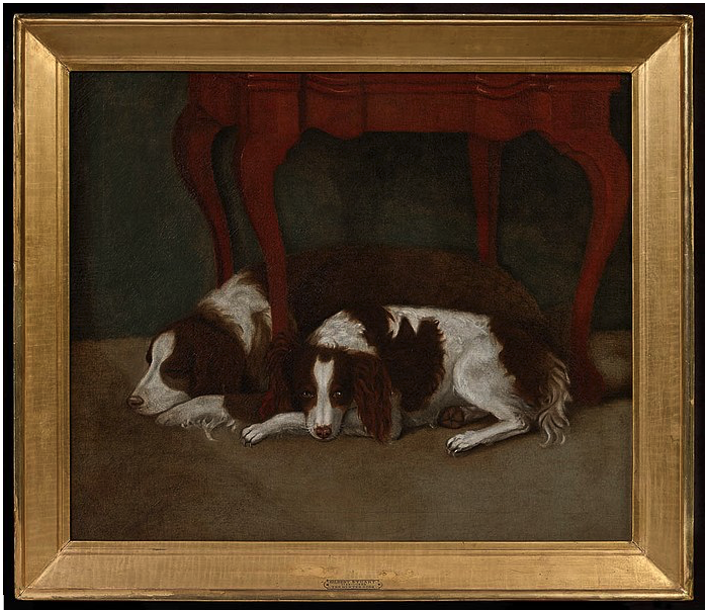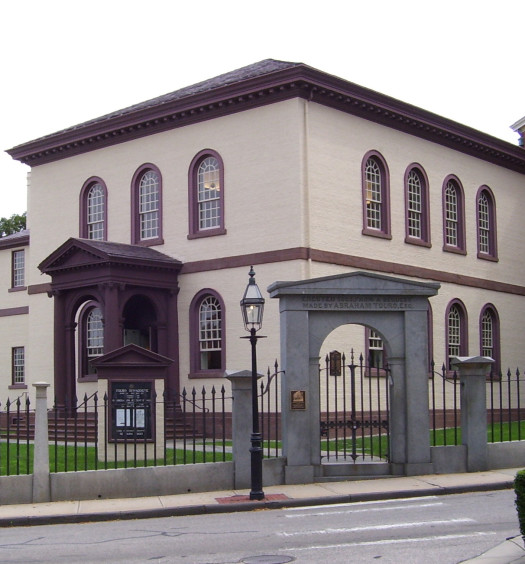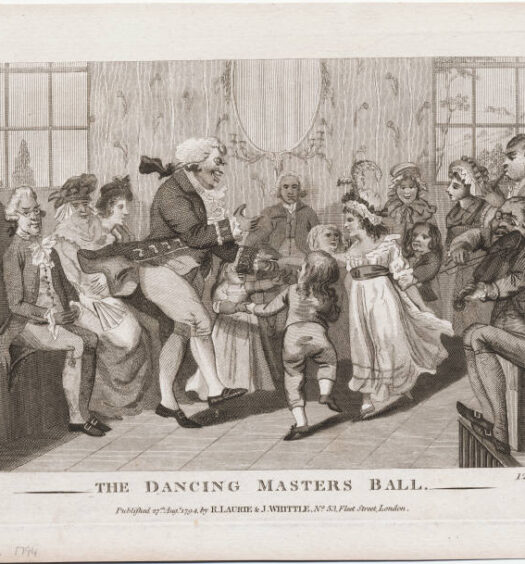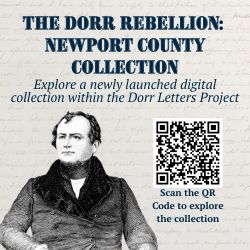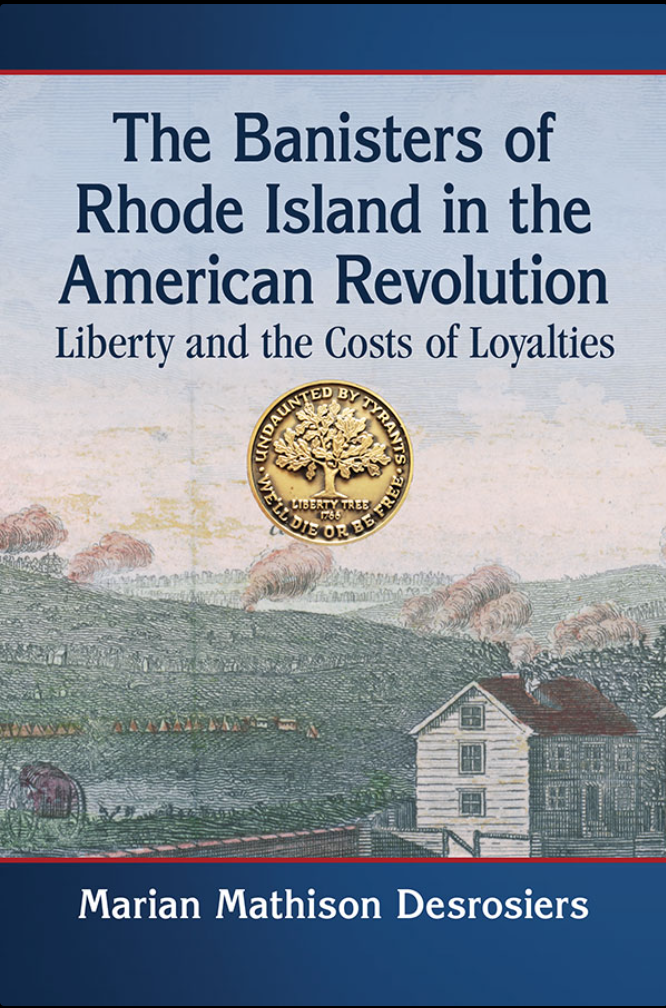We viewed the sea from a high rock…below us of three or four miles extent, a pleasant green meadow, thro’ the middle of which run a pritty winding river. Hamilton at Tower Hill, Sunday, July 15, 1744 [1]
In May 2022, Christian McBurney wrote an essay about the native animals of Rhode Island over the centuries, including a commentary that both red and grey fox existed at the time of Roger Williams. Two items came to mind from my research of the Banister family in Rhode Island. One was an image of a 1740 wax seal used by Newport colonial John Banister (1707-1767), which seal was attached to official documents. A hunting hound and two oak trees seemed a strange choice for a shipbuilder and merchant of the Atlantic world trade.[2] Also, there was a newspaper article about fox hunts in South Kingstown (which then included Narragansett) organized by his son John Banister II (1744-1807) for several years before 1800.
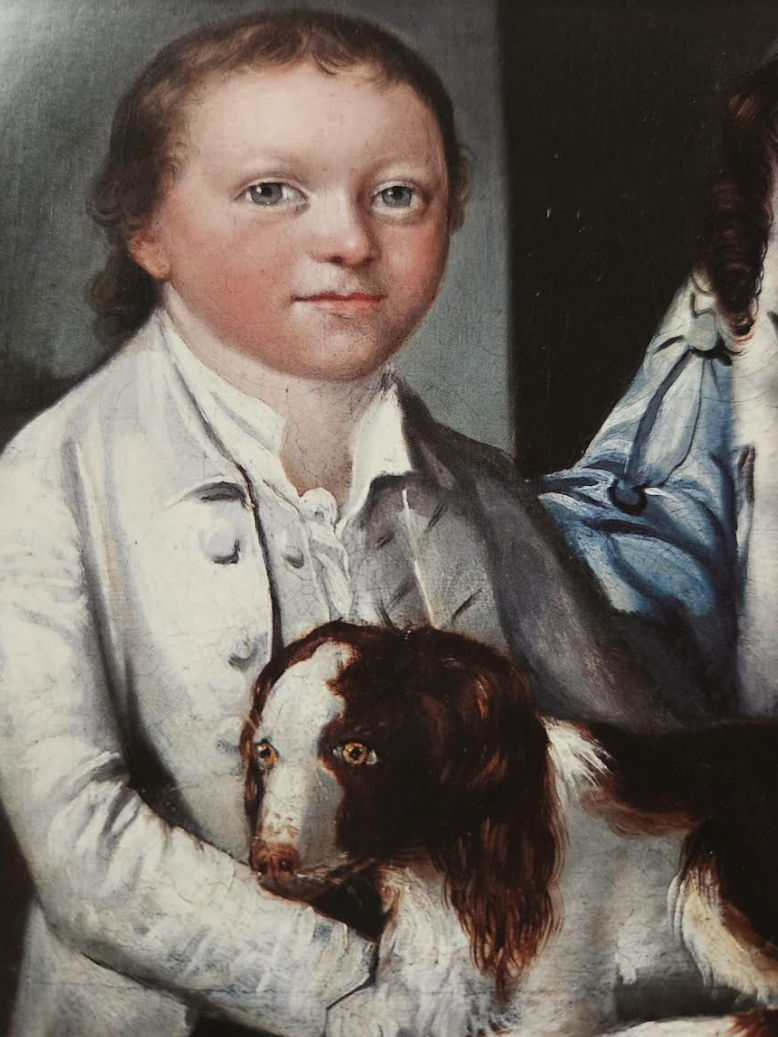
John Banister III and his Setter by Gilbert Stuart… Newport, Rhode Island (1774). Owned by Redwood Library and Athenaeum.
Is there a connection between the two items 60 years apart? From previous research on the Banister family, it was a fact that both men owned a hunting gun and they lived at a time when men used their ability to bring in birds, squirrels, and rabbits to supplement their regular diet of pork, veal, and fish. Both father and son rode horses, albeit not every day. The son John Banister II owned a dog, generally called “a hunter” as early as 1774, but was this rather a family pet? That is unknown, but there were families in Newport, who kept their hounds no longer outside in the yard but rather inside their homes. Gilbert Stuart painted the two spaniels of Dr. William Hunter in 1770 (when Stuart was only 14) and painted John Banister III at four years of age with his spaniel in 1774.[3]
Did colonials use their dogs to hunt? Fox populations were substantial in Rhode Island rural areas in the eighteenth century and sometime rose to numbers that might need control to stop their “depredation of the barnyard fowl.” A serious question is whether there were hunts in the style of the British gentry where the hunters dressed formally with horns calling the hounds to speed up or slow down. Recollections by the Hazards of South County, when they were octogenarians, spoke about those times in their youth. “The Hazards and Wilcoxes hunted foxes for recreation…in Narragansett,” i.e., for the chase to show their muscular power and athleticism while riding their steeds.[4] Thomas P. Hazard (1797-1886) wrote about “the fox chase with horses and hounds…an ancient pastime” of his family.[5]
In the 1930s, William Davis Miller, a Rhode Island historian, published a rebuttal to the possibility of organized hunts in Rhode Island. He looked in diaries, letters, and probate (inventories of property held at death) to find references to packs of hounds, hunting horns, or costumes for the hunt and found none. If indeed the hounds were of value, such as an ox or horse, Miller posited there would be talk of sales and monetary value posted. In terms of large groups of men with their dogs and horses chasing fox, historian Miller found no material evidence.[6]
And yet there is a news article that peaks the modern-day historian’s interest. Under “Tower Hill” in the October 17, 1873, edition of the Narragansett Times, printed in Wakefield, Rhode Island, James Wilson (1805-1898), speaks of the bygone era. Wilson was born at Tower Hill, located on the mainland side of the Pettaquamscutt River opposite Boston Neck. He lived in the area until his death, at one time teaching in the village school and working his trade as a carpenter. His family lived at Tower Hill from the time of the Pettaquamscutt Purchase in 1657.[7] Wilson stated that his information was from his grandfather John Wilson (1724-1815), who died at the age of ninety-one, and William W. Pollock (1732-1828), who passed at age ninety-six:
A few years anterior to 1800, John Banister, Col. John Gardner, Rowland Brown, John Hazard, Nathan Gardner, Christopher Potter, Joseph Perry, Daniel Tefft, and Jonathan Barber were in the habit of assembling in the autumn of each year at the tavern of Simeon Hazard near the residence of John L. Brown for their regular foxhunt which usually continued for two weeks.”[8]
In the autumn is when the crops are harvested and the trees have lost their leaves, making for improved visibility in meadow and forest. The fox is active just before sunrise and around sunset—not the easiest time for a hunter to see his prey. Additionally, fox can run up to thirty miles per hour through open meadow. How did this band of men hunt the fox, on foot or on horseback? Did they have hounds? What drew them together on this venture? Was it to keep foxes from attacking domestic farmyard animals? Was it to show off athletic skill? Or was the activity the last hurrah for a class of a certain social status in South County? The answers were surprising.
When John Banister II (1744-1807) of Newport returned from England in 1784, after the end of the American Revolutionary War, he decided to make South Kingstown a place of residence for his wife Christian Stelle and his fifteen-year-old son John III. Banister had spent his youthful years in the bustling seaports of Boston and Newport and in the 1780s lived in London, the largest city in Europe. For the owner of Banister’s Wharf, a former owner of warehouses for world-wide cargoes, and the owner of real estate properties devastated by the British occupation of Newport, western Rhode Island was a quiet space.[9]
In earlier times, the 1740s to 1760s, large landholdings in Narragansett Country near the river and ocean provided settlers with grazing acreage. Named after the Narragansett, the original indigenous peoples, the large estates encompassed areas both east and west of the six-mile long Pettaquamscutt River. Some of the largest farms were on the coastal peninsulas to the east, namely on Boston Neck, Little Neck, and Point Judith abutting Narragansett Bay and the Atlantic Ocean. The landowners bred horses (including the famed Narragansett Pacers), obtained wool from herds of sheep, and made cheese from large numbers of dairy cows. Enslaved laborers kept the economy going. Much of the surplus farm products was shipped by Newport merchants to the British-controlled Caribbean colonies. However, the wealth generated by the export trade began to decline even before the Revolution began in 1775 and the “carrying trade” with British colonies ended after the war. Following the American Revolution, the regional sale of grains and animals provided the main source of income.[10]
In this rural setting near the hamlet of Tower Hill, John Banister spent time during the decade after the war. From the hill the view to the sea revealed sailing sloops and rock outcrops from which one could see the ocean spray beating the tops of the rocks. Located on the Old Post Road (currently the intersection of Route 1 and Torrey Road), Tower Hill was one of the stagecoach stops, on the way north to the ferry to Providence and Jamestown or southward to Connecticut. It had also been one of the five rotating capitols of the colony and the seat of King’s County. However, life in Tower Hill slowed down after the relocation of the county courthouse and jail to Little Rest (later Kingston) in 1752. A school, meeting house, and burial ground, public house, tavern, blacksmith shop, tailor shop, and grocery continued to meet most of the daily needs of villagers for another sixty years. The Gale of 1815 broke the tops of most trees, destroying the bucolic beauty of the town. Before that Tower Hill had two dozen homes, each with a half dozen poplar trees mixed in with buttonwood, mulberry, willow, and hawthorn.

Tower Hill and Boston Neck from Henry F. Walling (1825-1889), Map of South Kingstown, Rhode Island, Philadelphia, PA, 1857. At the top right (north), is South ferry, the way of travel for John Banister II from South Kingstown to Newport by way of Conanicut (Jamestown) Island. South of the road to the ferry is Boston Neck and the estate of Col. John Gardner, the likely location for a fox hunt. Banister’s friend Rowland Brown lived in Tower Hill, which is a central feature to the west of Pettaquamscutt River.
Banister developed friendships with nine local South County men, two of whom would be considered wealthy, while the others were of modest means. Most volunteered for civic duties while working their days in a trade, as farmers or shippers. They were firm patriots who participated yearly in their local militias even after the war. Several of the men rode horses; most roads were not designed for carriages in this countryside. There was no record of owning foxhounds. Descendants of seventeenth century Narragansett Country plantation families, the surnames of Banister’s camaraderie are familiar, namely Barber, Brown, Gardner, Hazard, Perry, and Potter. Their enjoyment of hunting birds and small game in the wide-open salt meadows and vast tracts of woods and brooks of western Rhode Island bound them together. According to Wilson’s story told to him by his grandfather, it seems that in some of those post-war years the group of men met at a local tavern in the fall and rode together to chase fox, often celebrating the end of their day with a hearty meal.
Two of the men who joined Banister to ride after fox Rhode Island residents recognized for their wealth and political leadership include a Gardner and a Brown.
Colonel John Gardiner: Farmer and Politician
Colonel John Gardiner (1747-1808) lived on Boston Neck, east of the Pettaquamscutt River and along the shore Narragansett Bay. He served from 1775-1776 in the Kingston Reds, an independent militia company of men who received red uniform coats from the town. Noted as a horseman, he was Captain of the Troops of Horse, Third Battalion, in 1780. He was an accomplished gentleman, a Whig, who supported a republican rather than imperial approach to governing the American colonies. Gardiner served in the state legislature in the 1780s, as one of the leaders of the Country Party, which dominated state politics in the post-war years. The Country Party distrusted large and distant government that did not guarantee the protection of civil liberties; there was ongoing tension between rural farmers of western Rhode Island and the Providence merchants and nascent industrialists.[11] Those in the Country Party wanted the ability for the state to print money as legal tender and repay debts accumulated during the American Revolution for the face value of the paper money. Their influence meant that the state declined to dispatch delegates to the Philadelphia Convention in 1787 to draft the United States Constitution.[12]
Elected to the Congress by popular vote in 1788, Colonel Gardiner did not take his seat because of differences over the role of the national government; he was an anti-federalist, fearful of big government and long-distance governing. However, he continued to serve his community as a Justice of the Peace for South Kingstown. He inherited the family’s rich farmland of five hundred acres just south of South Ferry on Boston Neck. He died at the age of sixty-one and a slate tombstone carved by John Stevens marks his passing.[13]
One common bond for Gardiner and Banister was that they were both elected as Justices of the Peace for South Kingstown. As such, they dealt with local cases of small debts, landlord-tenant issues, misdemeanors, and infractions of local ordinances.
Rowland Brown: Owner of a Public House and Grocery
Rowland Brown (1754-1801) as a young man formed alliances with local Rhode Island families when he married first Hannah Hazard Babcock and then, after her death, in 1782 married Mary “Polly” Wickes (1752-1815) of Newport.[14] Among the early landholding families, the Browns owned hundreds of acres of land on Boston Neck. Rowland Brown in the 1782 Rhode Island census was head of a household in South Kingstown with eleven black laborers who worked on his farm.[15] The Brown family had a home at Tower Hill that was “at least 100 feet” in length and solid, being “heavy timbered with white pine sills 12-to-18-inch square.”[16] At Tower Hill “on the south side of the road by the brow of the hill,” Rowland Brown’s house had “a quadrangular front yard with an ornamental fence and arched gateway.” He paved the enclosure with stone and added shrubs, vines, and poplars. Rowland with his brother Thomas ran a hotel, dry goods store, and grocery here for decades. They installed a “stone horse mounting block eight feet long with steps” to make it easy for riders to climb onto their horses, or into a coach.[17]
Rowland served his constituents at three levels of public service. From 1771-1795, Brown is frequently on the pages posting a bond as administrator for the estate of a deceased town member.[18] In the May 1784 session of the General Assembly, Rowland represented South Kingstown, along with Rowse J. Helme, Esq. In the June 1784 session the state legislature appointed him to a committee with George Hazard, Jonathan Comstock, and Robert Stanton to survey the lands of Point Judith Farm in Washington County to create lots and farms for sale by the state. Prior to the Revolution, Loyalist Samuel Sewall of Boston owned a massive 1,600-acre farm, which the state confiscated. The legislators submitted a map of the six-lot division and the highway they surveyed with access from each lot. In May 1790, Brown served again as a representative to the General Assembly for South Kingstown, this time with Jonathan J. Hazard, the leader of the Country Party. In June 1791, Brown served on a committee to survey Indian lands and determine just compensation to the Narragansett.[19] Elected Justice of the Peace for South Kingstown, along with Nathan Gardner from May 1789-1791, Rowland continued his public service at the courthouse.
Brown was an accomplished horseman and Captain of the Washington County Troop of the Horse from 1792-1793.[20] As a result of his dedicated work, inheritance, and connections, he became one of the top taxpayers in South Kingstown. While the value of his property was $2,500 in 1782, by 1799, his share jumped to $8,500.[21] Those good times ended with the death of Banister’s younger friend Rowland before he was even fifty. When he died, Rowland’s estate was in “a complex situation” of accounts unpaid to the amount of $13, 225.93, which took two years to untangle.[22]
How John Banister became friends with Rowland Brown is unknown. When served as representative in the General Assembly in 1796, Brown swore he knew Banister for fifteen years (from 1781); Cousin George Brown, when he served as Justice of Superior Court, also swore he knew Banister for 8 to 10 years (from 1786). They likely moved in the same political and social network.
Banister served as Justice of the Peace in South Kingstown in 1788 and went on to serve in that same office in Newport from 1789 through 1793.[23] Banister kept a residence in South Kingstown from 1786 to at least 1799 and paid taxes there, on property valued at $800 in 1799.[24] Both men served their communities, paid local taxes, enjoyed horseback riding, and hunting.
If they did hunt together, as Wilson purports, they likely retired to one of the homes of the members for food and entertainment. There is at least one story of the friends of Rowland Brown returning from “a hard day’s fox chase” to the Brown “palatial mansion at Tower Hill, tired almost to death and hungry as the devil” to feast on “two splendid roast turkeys with all the fixings.” [25]
Six of the other men in the band of hunters seemed bound by the thread of patriotism for their native state during and after the American Revolution. They joined the South Kingstown militia or represented their community in the state legislature: Jonathan Barber (1745-1839), John Hazard (1746-1813), Simeon Hazard (1748-?), Joseph Perry (1752-1818), Christian Potter, and Daniel Tefft (1743-1818). Nathan Gardner, Jr. (1748-1802), fellow Justice of the Peace, and Simeon Hazard had income from their taverns, Joseph Perry assisted in managing the 500-acre farm of the Brown family, John Hazard and Daniel Teftt were farmers. Nathan Gardner was the brother-in-law of John Hazard. [26]
In conclusion, other than the one account, there are no other stories about fox hunts or fox chases in Rhode Island newspapers in the seventeenth, eighteenth, or nineteenth centuries. Why? Foxes that were hunted by organized groups on foot or on horseback with or without hounds may not have been a newsworthy event. Hunting fox with a group may have been a part of everyday hunting methods in rural areas, depending on the prevalence of the animal and whether they were destructive to farms, as happened in the 1930s and again in the 1960s. One key might be the number of fox hounds owned, but other than in paintings, that information is scarce.[27]
Old timers in western Rhode Island enjoyed their end of summer horse racing at the beach with feasts of baked lobster, oysters, and quahogs, as well as their autumn festivals filled with dancing and music after picking the corn and husking.[28] Families in South County held tight to their memories and the chase just may have been one of them. As much as they wanted to control the numbers of fox, those who were horse lovers may have been just as eager to show they could ride fast up and down hill, jump over brooks and stone walls, and race each other for over two hours. The hunting adventures of Banister and his contemporaries in South Kingstown seem to have reflected a way of expressing their comradery more than an attempt to mimic a societal activity of British gentry.
[1] Alexander Hamilton (1712-1754), Itineraries of 1744, edited by Albert Bushnell Hart (The DeVinne Press, 1907). Accessed at https://www.loc.gov/resource/lhbtn.02374/?sp=191. [2] The Rhode Island Historical Society has an image of the seal in the Tillinghast Papers Mss 757. The red wax seal was used on a document signed by John Banister for the sale of a house and lot in the Lower Mill Field, February 27, 1741, to Joseph Tillinghast (1728-1789). [3] George Stubbs and Thomas Gainsborough painted English gentry and royalty with their family dogs in the mid-eighteenth century. Poets Alexander Pope and Robert Burns wrote about the fidelity that dogs showed to their owning families. [4] Wilkins Updike, A History of the Episcopal Church in Narragansett (Boston: Merrymount Press,1907), 227. [5] Thomas P. Hazard (“Shepard Tom” (1797-1886)), Recollections of Olden Times (Newport: Sanborn Publishers, 1879), 110; Maud Howe Elliott, “Newport: Cradle of American Sports,’’ Newport Historical Magazine, Oct. 1933. Elliott wrote about the stories told to her by her relative Mr. Hazard who lived in Portsmouth. [6] William Davis Miller, “Fox Hunting in Colonial Rhode Island,” Rhode Island Historical Society Collection 27 (1934), 33-38. Formal hunts took place in Virginia, Maryland, and New York during the eighteenth and nineteenth centuries. [7] The New England Historical and Genealogical Register (Boston, MA: New England Historic Genealogical Society), vol. 144, 316. Online database: AmericanAncestors.org, New England Historical Genealogical Society, 2001-2018. https://www.americanancestors.org/DB202/i/11735/316/235136462.
James Wilson was the son of Robert Arnold Wilson and Mary Polly Knowles. James married twice, the first time in 1827 to Sarah Ann Gardner and, after her passing, the second in 1852 to Julia A. Mott. He lived his last days in Peace Dale and is buried at Oakdell Cemetery (Rhode Island Historic Cemetery #37, South Kingston, Sec. 1 Lot 10).
[8] James Wilson, “Tower Hill,” Narragansett Times [Wakefield, RI], October 17, 1873, 1. Wilson relates that Commodore Oliver Hazard Perry’s parents lived in Tower Hill at the Case house, where the young man was born in 1785. [9] See Marian Mathison Desrosiers, The Banisters of Rhode Island in the American Revolution: Liberty and the Costs of Loyalties (Jefferson, NC: McFarland Publishing, 2020). [10] “South Kingstown,” Rhode Island Historic Preservation Commission Survey, 1984, 1-13. South Kingstown Tax Lists 1773-, 1791 and Property Lists for Tax Assessors 1773-1786. South Kingstown Town Hall. [11] Hazard, Recollections of Olden Times, 19. South Kingstown paid one-third more taxes than Providence during the 1780s. This was one of the reasons for the rise of the Country Party. [12] Christian M. McBurney, A History of Kingston, Rhode Island: Heart of Rural South County (Kingston, RI: Pettaquamscutt Historical Society, 2004). [13] Vital Record of Rhode Island, vol 10, 840; J.R. Cole, The History of Washington and Kent Counties, Rhode Island (New York: WW Preston & Co. 1889), 534. Colonel Gardiner was well connected. His uncles were Dr. Sylvester Gardiner and Rev. James McSparran, by marriage. One sister, Abby, married Lodowick Updike, who owned what is now Smith’s Castle in North Kingstown. Lydia Gardiner married Robert Champlin of Newport, brother of Newport merchant Christopher Champlin and they had a daughter Mary. She then married John Faxon of Newport, who bought a former Thomas Banister property at 199 Spring Street. [14] Guardian of Liberty, June 27, 1801. “Rowland Brown Lot, South Kingstown Historic Cemetery 98,” in John E. Sterling and James L. Wheaton, IV, Historical Cemeteries of South Kingstown, Rhode Island, ed. Cherry Fletcher Bamberg (Greenville, R.I.: RIGS, 2004). The gravestone has carved winged cherubs on the large slate by John Stevens. Updike, History of the Church, Entry #809. Rowland Brown was a cousin of the children of Robert Brown (1718-1762) and Sarah Franklin (1725-1762?), who married in Jamestown on August 29, 1745). Robert Brown was the brother of George Brown (1746-1836), once a lieutenant governor of the state and later a judge. [15] The Census for the State of Rhode Island for 1782, edited by Jay Holbrook (Oxford MA: Holbrook Research Institute, 1979). The Perry family had four enslaved people working for them on their farm, while the Gardner families had between 6 and 7 enslaved people. Ibid. [16] Thomas Robinson Hazard (1797-1886) and Rowland Hazard (1801-1888), The Johnny Cake Papers of Shepard Tom (Boston: Merrymount Press, 1915), 324. [17] Ibid. [18] South Kingston Town Records 1771-1795, edited by Jean C. Stutz (Kingston, RI: Pettaquamscutt Historical Society, 1988), 107,121,133, 191, 203, 209, 250, 268, 276, 295, 298, 321, and 324. [19] Records of the Colony of Rhode Island and Providence Plantations in New England 1636-1792, edited by John R. Bartlett (Providence: A.C. Green, 1856-1865), vol. 10, 20, 50, 375, and 443. Similarly, Rhode Island Loyalist Robert Hazard lost his 1,600-acre Boston Neck farm, which the state divided into six lots. The state confiscated the 700-acre farm on Boston Neck from George Rome of England. Updike, History of the Episcopal Church, entry #318, 692. [20] Military and Political Lists of Rhode Island 1647-1800 from the Records of the General Assembly, edited by Joseph Jenckes Smith (Providence: Preston and Rounds, 1900), 456, 469, 478, 488, and 499. Rowland first served in the Kingston Reds in 1775. [21] Tax Lists for South Kingstown, Rhode Island 1730-1799, edited by Judith Greene Watson (Rockland,Maine: Picton Press, 2007).
[22] South Kingstown Probate Book, 1799-1807, 169-174, South Kingstown Town Hall. [23] Case of Banister and Land Inherited by Will from Dr. John Baker of New York, Vault A, Box 121, Folder 3. Newport Historical Society; Smith, ed., Civil and Military List of Rhode Island, 456. See also Deeds in the Land Evidence Records of Newport City Hall, where Banister of South Kingstown is the grantor. He provides the census taker with South Kingstown as his residence in the Federal Census of 1790. Also, Banister gave a deposition September 2, 1795, about a British war ship off Whale Rock that summer, which he saw while riding or walking on the Neck. See US Congress, Senate, Executive Department Document No. 4, 186: 1-53, 37th Cong., 3rd sess., Washington, 1863. See Watson, Tax Lists of South Kingstown, 19. [24] Watson, Tax Lists of South Kingstown, 401, 447, 474, 501, 510, 530. In 1786, Banister had a $30 rateable estate in South Kingstown. In 1798 it increased to a $1,500 rateable estate. Banister is not listed as an owner of real estate in the land evidence records of South Kingstown; therefore, he was likely renting. Henry B. Gardner, The History of Taxation in Rhode Island to 1790, Dissertation. Johns Hopkins University, 1890. Accessed at https://www.gutenberg.org/files/63441/63441-h/63441-h.htm. A rateable estate could be a mill, wharf, livestock, slave, silver, stocks or bonds, hay, wood, or a boat. Banister also paid taxes in Newport as the state determined that each town could tax owners who did not live in the town, even if the land was undeveloped. [25] Hazard and Hazard, The Johnny Cake Papers, 323. More stories of life on the Neck are on pages 208, 315, 319, 321, 337, 346, and 360. [26] Caroline E. Robinson, The History of the Hazard Family 1635-1894 (Boston: privately printed, 1895), 40. [27] Narragansett Times, December 25, 1931. When the red fox population became destructive to poultry and game, a group of men organized a Sportsman’s Club in South Kingstown. The state awarded bounties of $1 to $5 per pelt. Pelts later sold at $25. The club purchased full-blooded hounds for the hunt. Narragansett Times, January 20, 1966. However, that club was nothing like the 1872 Providence County Hunt Club in Warwick in imitating the English fox hunt, or like the 1897 Agawam Hunt Club. Increasing numbers of red fox were attacking poultry as well as quail, geese, pheasant, and rabbit. The town clerk in South Kingstown reported, “there are generally 40-50 pelts turned in by farmers who hunt them and receive $3 a pelt.” [28] Updike, History of the Church, 307.


